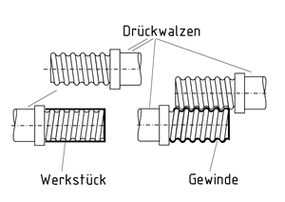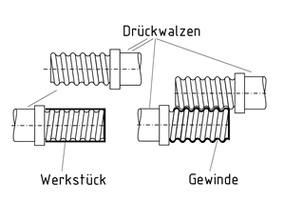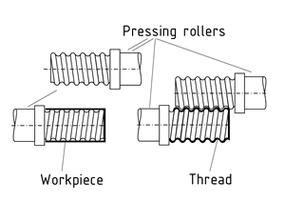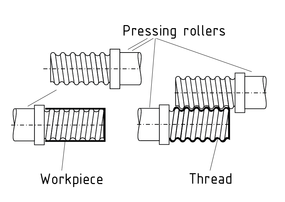
Seleccione uno
o más idiomas
0,1,3
- Alemán
- Inglés
- Chino
- Español
Hilado de rosca

El del hilado de rosca se usa principalmente para la fabricación de roscas redondas en materiales laminados. Los machos de conformado se usan, por ejemplo, para la fabricación de roscas internas. Durante la producción de roscas, el macho (un rotativo) se inserta en el orificio central pretaladrado. Otro rodillo de prensado rotativo se empuja contra el primero desde afuera. En lugar de cortar con el golpeteo, el material es conformado en frío entre los rodillos sin interrumpir el flujo de la fibra del material. Esto incrementa la capacidad de carga de la rosca. Después de la deformación plástica, el material constituye el diámetro de la rosca.
El diámetro a ser cortado depende en gran parte del material de la pieza de trabajo, de la geometría de la pieza de trabajo (piezas con paredes delgadas) y de la capacidad de carga deseada de la rosca.
Hilado de rosca
Gewindedrücken

Das nichtspanende Umformverfahren Gewindedrücken wird meistens bei der Herstellung von Rundgewinden in Blechen angewendet. Eingesetzt werden beispielsweise Gewindeformer für die Herstellung von Innengewinden. Der Former (eine rotierende Drückwalze) wird bei der Herstellung des Gewindes in das vorgebohrte Kernloch eingedrückt. Eine weitere rotierende Drückwalze wird von außen dagegen geführt. Im Gegensatz zum Gewindebohren wird der Werkstoff nicht geschnitten, sondern zwischen den beiden Walzen kalt verformt, ohne den Faserverlauf des Werkstoffs zu unterbrechen. Dadurch entsteht eine höhere Tragfähigkeit des Gewindes. Der Werkstoff bildet nach der plastischen Verformung den Durchmesser des Gewindes.
Der zu bohrende Durchmesser ist stark vom Werkstückmaterial, der Werkstückgeometrie (dünnwandige Teile) und der gewünschten Traglast des Gewindes abhängig.
Thread spinning

The non-Machining process of thread spinning is mainly used for the manufacture of round threads in sheet materials. Forming taps are used, for example, for the manufacture of internal threads. During thread production, the tap (a rotating pressing roller) is inserted into the pre-drilled core hole. Another rotating pressing roller is pushed against it from outside. Instead of being cut as with Tapping, the Material is cold-formed between the two rollers without disrupting the fibre flow of the material. This increases the carrying capacity of the thread. After plastic deformation, the material constitutes the thread's diameter.
The diameter to be cut is highly dependent on the workpiece material, workpiece geometry (thin-walled parts) and the desired load-carrying capacity of the thread.
螺纹旋压

螺纹旋压的 主要用于在片材中制造圆螺纹。如加工内螺纹可能会使用丝锥。在螺纹生产中,旋塞(旋转)被插入预钻芯孔。另一个旋转压辊从外面反推。与攻丝切断不同,材料是在两个辊之间通过冷成形制得的,且不破坏材料的纤维流。这样增加了螺纹的承载能力。塑性变形后,材料形成了螺纹直径。
要切割的直径高度依赖于工件材料、工件几何形状(薄壁零件)和螺纹的所需的承载能力。
螺纹旋压
